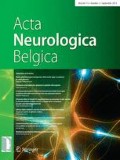We don't need 'hope'. Survivors want recovery and results! WHOM is going to do the followup research to find concrete answers? With NO leadership and NO strategy in stroke; NOTHING WILL BE DONE.
Corticospinal tract: a new hope for the treatment of post-stroke spasticity
Abstract
Stroke is the third leading cause of death and disability worldwide. Post-stroke spasticity (PSS) is the most common complication of stroke but represents only one of the many manifestations of upper motor neuron syndrome. As an upper motor neuron, the corticospinal tract (CST) is the only direct descending motor pathway that innervates the spinal motor neurons and is closely related to the recovery of limb function in patients with PSS. Therefore, promoting axonal remodeling in the CST may help identify new therapeutic strategies for PSS. In this review, we outline the pathological mechanisms of PSS, specifically their relationship with CST, and therapeutic strategies for axonal regeneration of the CST after stroke. We found it to be closely associated with astroglial scarring produced by astrocyte activation and its secretion of neurotrophic factors, mainly after the onset of cerebral ischemia. We hope that this review offers insight into the relationship between CST and PSS and provides a basis for further studies.
Introduction
Stroke is the third leading cause of death and disability worldwide [1]. Post-stroke spasticity (PSS) is the most common complication of stroke but is only one of the many manifestations of upper motor neuron syndrome. Over time, PSS continues to develop without effective interventions, and the disease worsens [2]. Twelve months after stroke, 43.2% of survivors develop spasticity [3]. Spasticity is as high as 97% among survivors of chronic stroke with moderate-to-severe dyskinesia [4]; this places a heavy economic burden on patients’ families and wider society. Therefore, more effective therapies are required to promote recovery from PSS.
Treatment of PSS has largely focused on reducing the area of cerebral ischemia and rescuing neurons from damaged areas of the brain; however, the effects of putative neuroprotectants are less pronounced in clinical trials [5]. Several recent clinical studies report that the degree of corticospinal tract (CST) damage correlates with the severity of spasticity in patients with chronic stroke [6,7,8] and that there is a significant correlation between motor function improvement and CST remodeling in patients with PSS [9]. A few experimental studies have also observed that by destroying the corresponding CST, the upper motor neurons lose control of the spinal cord, causing spasticity of the contralateral limb [10]. While the pathogenesis of PSS is more complex, the more established mechanism is that PSS is a maladaptive manifestation of the loss of supraspinal inhibitory modulation of spinal reflex pathways, which occurs through a functional reorganization at different levels, involving a physiological mechanism of mutual inactivation of motor centers and excitation of peripheral spinal cord segmental neurons; it is one of the syndromes of upper motor neurons [2, 11]. The CST, as an upper motor neuron [12], is the only direct descending motor pathway and is the main pathway innervating spinal motor neurons closely related to the recovery of limb function after stroke [13]. This suggests that CST is closely related to the pathological mechanisms of PSS. Many studies have demonstrated that motor recovery after stroke depends mainly on the plasticity of the damaged lateral primary motor area, evident through stroke patients and experimental animal studies [14,15,16], or on the homologous CST axon integrity [17,18,19,20]. Spasticity is a common disorder that coexists with dyskinesia after stroke [21,22,23,24], and it does interfere with motor recovery after stroke as PSS and other dyskinesias are essentially clinical manifestations of abnormal neuroplasticity and manifestations of common processes [25]. Therefore, promoting axonal regeneration of the damaged side of the CST may be a novel avenue for the treatment of post-stroke spasticity; however, only a few studies exist on the specific link between the CST and PSS, the remodeling of CST after stroke, and the recovery promotion of PSS.
This review aimed to provide an overview of the pathophysiological mechanisms of PSS, including the types of spastic hemiparesis, the close correlation between CST and PSS, and the relationship between PSS and motor recovery. We further reviewed the therapeutic strategies to promote axonal regeneration of the CST after stroke. We found that the astroglial scar and its secreted neurotrophic factors, mainly associated with the activation of astrocytes after the onset of cerebral ischemia, are important for remodeling the CST after stroke. This provides potential novel avenues for the treatment of PSS. Finally, we briefly describe the clinical treatment of PSS in cases where the cerebral cortex is severely damaged, and the cortical inputs are not re-established.
More at link.

No comments:
Post a Comment